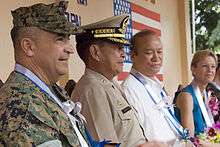Ramon Magsaysay Jr.
Ramon "Jun" Banzon Magsaysay Jr. (born June 5, 1938) is a Filipino politician and businessman. He is the son of former Philippine President Ramon Magsaysay.
Ramon B. Magsaysay Jr. | |
|---|---|
 Senator Ramon B. Magsaysay Jr. (third from left) | |
| Senator of the Philippines | |
| In office June 30, 1995 – June 30, 2007 | |
| Member of the Philippine House of Representatives from Zambales' Lone District | |
| In office December 30, 1965 – December 30, 1969 | |
| Preceded by | Virgilio Afable |
| Succeeded by | Antonio Diaz |
| Personal details | |
| Born | Ramon Banzon Magsaysay June 5, 1938 Manila |
| Nationality | Filipino |
| Political party | Liberal Party |
| Other political affiliations | Lakas (1995–2005) PRP (1992–1995) |
| Relations | Ramon Magsaysay (father) |
| Alma mater | De La Salle University |
| Occupation | Businessman |
| Profession | Civil service/Businessman |
Early life and career
Magsaysay Jr. was born in Manila to former president Ramon Magsaysay and Luz Banzon. He was 15 when his father was elected president and was 18 when his father died in a plane crash in Cebu. He graduated in De La Salle College in Manila where he earned a degree in mechanical engineering. He pursued post-graduate studies in 1962 at Harvard School of Business Administration in Boston, Massachusetts, and spent another year in New York University Graduate School of Business Administration. In 1960 he worked as an engineer trainee at Procter and Gamble Philippines. From 1961 to 1962, he was a supervising engineer for operations for Caltex Philippines.
Business career
After a productive four-year in Congress representing the lone district of Zambales, he returned to work in the private sector where he ventured into various industries including garment manufacturing and export, semi-conductor, and travel and tourism. Armed with his business education and engineering skills, Jun pioneered the cable television business in the country. Today, with over 550 cable operators nationwide, the cable TV industry business has turned into a multi-billion broadband industry. In recognition of setting the blueprint for the sector, Magsaysay is known as The Father of Cable Television.
- 1969–1995 Reserve officer, Lt. Jr. Grade, Philippine Navy
- 1972–1995 Company president, Colorview CATV Inc.
- 1975–1995 Company president/chairman of the board, RMJ Corp.
- 1970–1975 Company vice president, Gelmart Industries Phils. Inc.
- 1978–1985 Company director, Labtech Manufacturing Industries Inc.
- 1988–1990 Business columnist, Philippine Daily Inquirer
- 1989–1995 Company president, Cable Communications Inc.,
- 1989–1995 Chairman of the board, Dynatravel Management Corp.
- 1991–1995 Company president, Country Communications Network Inc.
- 1994–1995 Chairman of the board, Asian Cable Communications Inc.
- 2011–2012 Chairman of the board, Legaspi Oil Corp. and co-chairman of the CIIF-Oil Mills Group
Political career
House of Representatives (1965–1969)
In 1965, he was elected as a congressman for the lone district of Zambales. He was the youngest Congressman to be elected to the Lower House at the age of 27. He went back to the private sector soon after.
1992 Vice-Presidential bid
In the 1992 elections, he was offered by Agrarian Reform secretary Miriam Defensor Santiago to be her vice presidential candidate under the People's Reform Party. He accepted the offer and run for the elections, hoping to follow his father's footsteps, but the voters favored actor and Senator Joseph Estrada. He went back to the private sector soon after.
Senator of the Philippines (1995–2007)
In the 1995 elections, President Fidel Ramos invited Magsaysay to join the senatorial slate of the Lakas-Laban Coalition. He won the election and received the third highest vote among the twelve elected senators. In 1996, he was commissioned by the Senate to look for a suitable place to relocate the Senate offices. The building would be renovated as the National Museum would be expanding in time for the Philippine Centennial celebrations in 1998. The Senate session hall and offices found its new home at the GSIS Building in the Financial Center in Pasay City.
On January 13, 2001, Magsaysay was one who voted in favor of opening the bank envelope containing evidence in the impeachment case of President Joseph Estrada. The request was overturned by a negative vote that led to the second EDSA People Power Revolution. In the 2001 elections, he was reelected to the senate under the Lakas-NUCD-UMDP party and was affiliated with the People Power Coalition. In the electoral crisis involving President Gloria Macapagal Arroyo, Magsaysay distanced himself from the ruling party Lakas and joined the Liberal Party (LP) then led by Senate President Franklin Drilon. He is running for a seat in the senate in the 2013 elections under the Liberal Party of President Benigno Aquino III.
As a legislator, he has co-authored several laws including:
- Anti-Money Laundering Act of 2001 (RA 9160)
- Electronic Commerce Law (RA 8792)
- Ban on Hard Surfactants (RA 8970)
- Magna Carta for Small and Medium Enterprises (RA 8289)
- New Foreign Investments Act (RA 8179)
- Mechanical Engineering Law (RA 8495)
- Amending the Omnibus Investments Code – Regional Headquarters (RA 8756)
- Jewelry Manufacturing Act (RA 8502)
Personal life
Jun, as many people call him, is married to Marie Louise (Marilou) Kahn, and they have no children. However, he had two children from his first marriage, Francisco and Margarita.